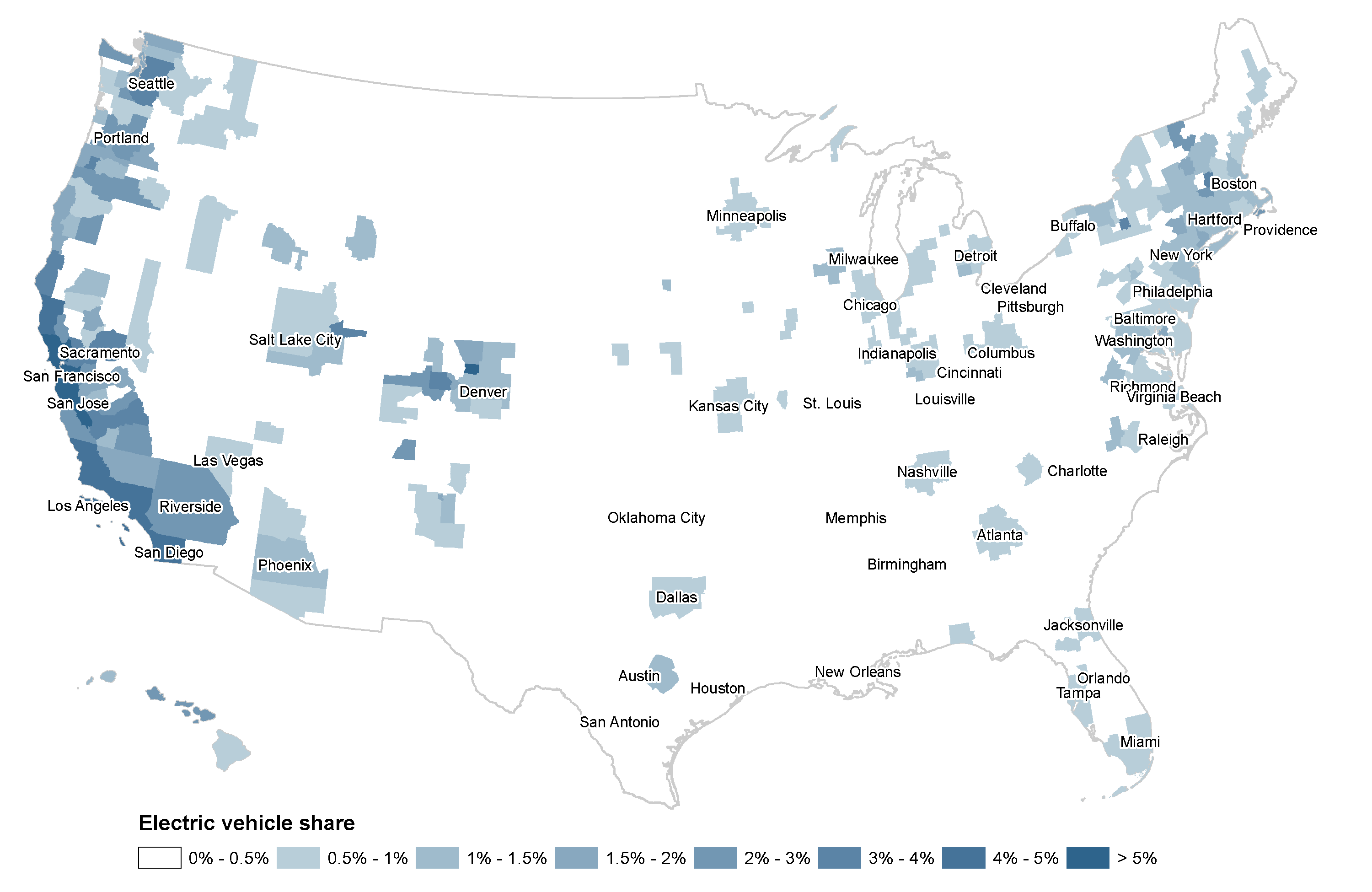White paper
The continued transition to electric vehicles in U.S. cities
This paper analyzes electric vehicle market development in the U.S. and the actions that are driving it. The report catalogues forty unique city, state, and utility electric vehicle promotion actions and their implementation across the 50 most populous U.S. metropolitan areas in 2017. The work identifies exemplary practices and discerns connections between various state and local policies, public and workplace charging infrastructure, consumer incentives, model availability, and the share of new vehicles that are plug-in electric.
The figure illustrates the share of new vehicle registrations that are plug-in electric (both fully electric and plug-in hybrid) across U.S. metropolitan areas in 2017, with the 50 most populous areas labeled. As shown, the San Jose area had the highest share at 13%, followed by other California areas at 5 to 8%. Top markets in Colorado, Oregon, New Hampshire, New York, and Washington had shares of 3 to 5%. Overall, the share of new vehicles that are plug-in electric in these 50 areas is 1.6%, exceeding that of the rest of the United States by a factor of about 2.5.

Based on the analysis, the authors offer four main conclusions:
Electric vehicle market growth requires many actions by many different players. Actions by various stakeholders are linked with electric vehicle uptake. Many local, state, and utility stakeholders across the United States are reducing consumer barriers with policy, incentives, and awareness campaigns. States that adopt California’s Zero Emission Vehicle regulation catalyze the market, spurring automaker marketing and expanded model availability. This provides assurance of a growing market and is typically complemented by policy incentives, sustained charging infrastructure investment, and consumer awareness measures.
Growth in electric vehicle uptake starts with expanded model availability. This research affirms a statistical link between electric vehicle model availability and uptake. The top five electric vehicle markets by volume, representing nearly half of all U.S. electric vehicle sales, each had at least 28 available electric vehicle models in 2017. However, across major U.S. markets, about half of the population has access to 10 or fewer electric models, indicating how limited electric vehicle exposure generally is. Availability of more models in more vehicle segments, especially lower-cost and higher-range electric vehicles, is a key to continued electric vehicle market development.
Even as electric vehicle costs continue to decline, consumer incentives remain important. Electric vehicle prices have greatly decreased even as their electric ranges have increased, reflecting great progress in battery technology and its increased production scale. Yet electric vehicle uptake continues to be linked to incentives that reduce the effective electric vehicle cost. Substantial consumer incentives, typically worth $2,000 to $5,000, were available in nine of the top 10 major metropolitan areas with the highest uptake. Consumers in California markets, Denver, and Seattle have benefited from substantial purchase incentives. Additional perks from carpool lane access and/or preferential parking policies benefit electric vehicle drivers in several markets, including Nashville, Phoenix, Raleigh, Salt Lake City, and many areas in California.
Electric vehicles and various types of charging infrastructure grow in unison. Public regular, public fast, and workplace charging are each linked with electric vehicle uptake. Markets with high electric vehicle uptake have at least 300 public charge points per million people; by contrast, half of the U.S. population lives in a market with charging infrastructure at least 70% below this benchmark. In the top electric vehicle markets, about 10 to 20% of the available public charging is fast charging. In addition, new to this report, we find that the top electric vehicle markets typically have at least 100 workplace charge points per million people
